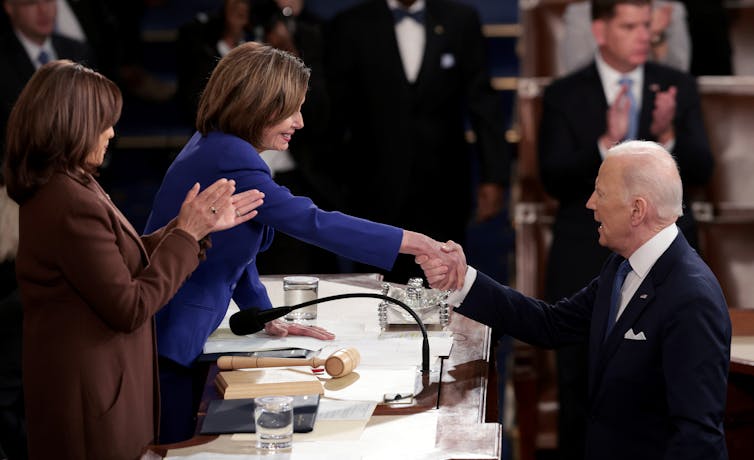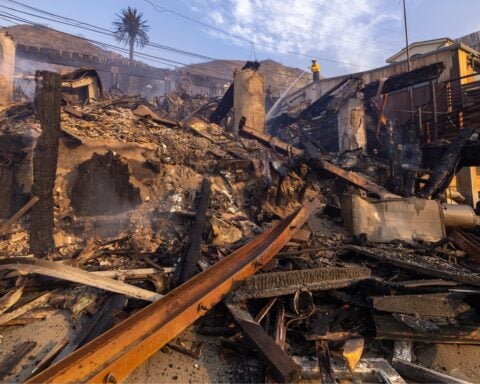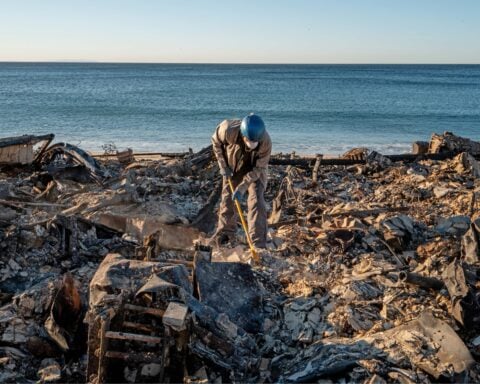For many observers, a key takeaway from the recent leadership struggle in the U.S. House is that Democrats skillfully manage their caucus while Republicans are uniquely dysfunctional.
This claim is based in large part on a comparison between Republicans’ perceived disloyalty in removing their speaker, Kevin McCarthy, during the current Congress and Democrats’ apparent loyalty toward their speaker, Nancy Pelosi, in previous Congresses.
At first glance, this seems to be a fair comparison. Both parties have dissident – or anti-establishment – factions that sometimes chafe at the compromises made by their leaders. They include “the Squad” for Democrats and the Freedom Caucus for Republicans.
And both parties have lately held narrow majorities when in power, which gives potential leverage to these factions.
So why do Republicans seem to be having a harder time with these similar circumstances than do Democrats? Is it the relative skill of their respective leaders? Are Republicans simply more dysfunctional?
I am a scholar of Congress, political parties and elections. And I would argue that, other than possible differences in leadership skill or caucus dysfunction, there are three important factors that can help explain the observed differences in outcomes for the two parties:

1. The motion-to-vacate rule
When she regained the speakership in 2019, Pelosi perceived that she might face the same sort of internal party threats to remove her as McCarthy eventually did four years later.
This is why she changed the House rules to increase the threshold of support that was required to bring a formal motion to vacate the speakership, which stood then at a single lawmaker. The revised rule required the support of a majority of either party’s caucus in order to force a vote. This rule helped Pelosi keep her speakership secure even in the face of internal party divisions similar to those on the other side of the aisle.
That rule would have saved McCarthy. However, he negotiated it away during his effort to become speaker, so that once again it took only one lawmaker to force a vote that could end up bringing down the speaker.
You could argue that reverting to the single-lawmaker rule is simply another example of inferior strategic thinking by GOP leadership. But I believe it is possible that no Republican candidate could have avoided making this concession. After all, McCarthy first tried offering only a partial change – agreeing to lower the threshold down to five – but still could not secure the votes he needed until finally agreeing to a threshold of one.
2. Which party is in the White House
During the previous Congress, the House majority – Democrats – was from the same party as the sitting president, Joe Biden. The members of the president’s party in the House knew that if the chamber got sidetracked with a speakership fight, their president’s agenda would also be sidetracked.
In turn, this could diminish the president’s public approval ratings.
Since Biden is the public face of the Democratic party, when his approval dips, this harms the relative electoral prospects of all candidates running for reelection under his party’s label. So, Democrats had an incentive to cooperate, for fear of losing their own seats and their party’s majority in Congress.
In contrast, during the current Congress, the Republican majority faces a president from the opposite party. This circumstance can create an incentive for the majority party to prevent the president from achieving legislative successes. Poor ratings for Biden could help Republicans running for reelection. In this context, a speakership fight that sidetracks legislation makes more sense from the party’s perspective: It could even help the party in the next election.
3. Ideology
Finally, dissidents in the Republican Party have greater leverage than their Democratic counterparts based on their ideas about policy and governing.
Democrats generally agree that a functioning government is needed to help solve societal problems. So, dissident factions in the Democratic Party are typically unwilling to shut down government operations indefinitely in order to extract concessions from their leadership.
In contrast, Republicans are more likely to believe, as President Reagan famously stated, that “government IS the problem.” This means that dissident factions in the Republican Party can much more credibly threaten to indefinitely halt government operations – doing so does not conflict as much with their policy goals. In turn, the fact that they have less incentive to drop their obstruction gives them more leverage over their party’s leadership.
It’s more complicated than you think
Would Republicans have moved to vacate the speakership if Donald Trump were in the White House and eager to pass his conservative legislative agenda? Would Pelosi have survived without changing the rules?
You can never know the answers to these questions for certain. But thinking about these hypothetical situations helps illustrate that political context matters. How members of a party will behave in a given situation is affected by many factors, including congressional rules, election pressures and policy preferences. Sometimes, these factors simply align in a way that makes it hard to be the speaker.

David R. Jones does not work for, consult, own shares in or receive funding from any company or organization that would benefit from this article, and has disclosed no relevant affiliations beyond their academic appointment.
Source: The Conversation

 Republican bill seeks to curtail US FTC's merger-busting powers
Republican bill seeks to curtail US FTC's merger-busting powers
 UnitedHealth investors await details behind 2025 outlook after exec's murder
UnitedHealth investors await details behind 2025 outlook after exec's murder
 Texas online porn age-verification law goes to US Supreme Court
Texas online porn age-verification law goes to US Supreme Court
 Former Georgian prime minister hospitalised after beating, blames government
Former Georgian prime minister hospitalised after beating, blames government
 Mussolini's honorary doctorate subject of Swiss university exhibition
Mussolini's honorary doctorate subject of Swiss university exhibition
 Italy's public debt tops 3 trillion euros, highest on record
Italy's public debt tops 3 trillion euros, highest on record
 Overtourism was the buzzword of 2024. This summer looks to be just as crowded and chaotic
Overtourism was the buzzword of 2024. This summer looks to be just as crowded and chaotic
 Spain sees further tourism growth after record 94 million visitors in 2024
Spain sees further tourism growth after record 94 million visitors in 2024
 Tabulating votes during one of the many ballots held by House Republicans to choose a speaker.
Tabulating votes during one of the many ballots held by House Republicans to choose a speaker.







